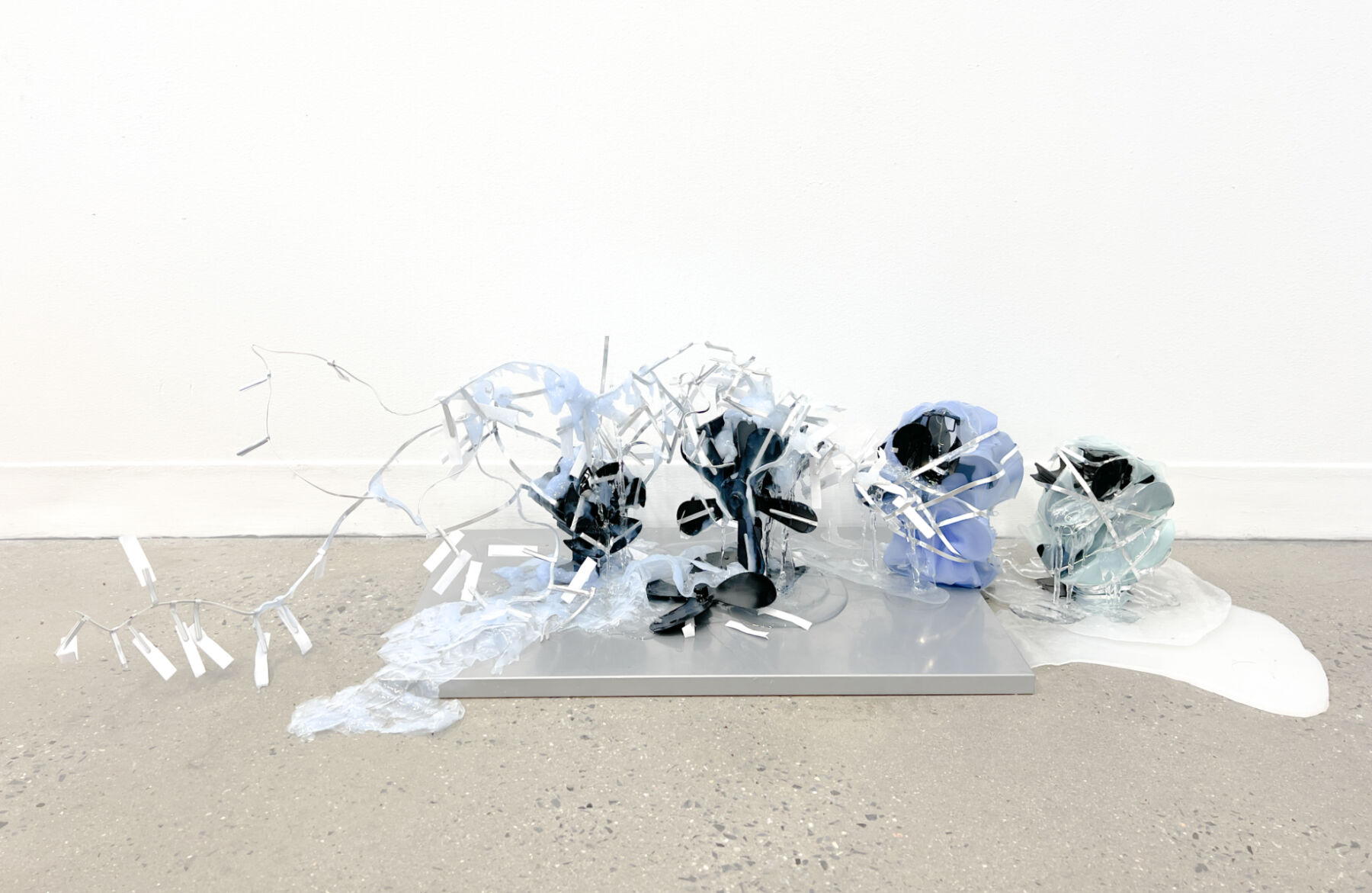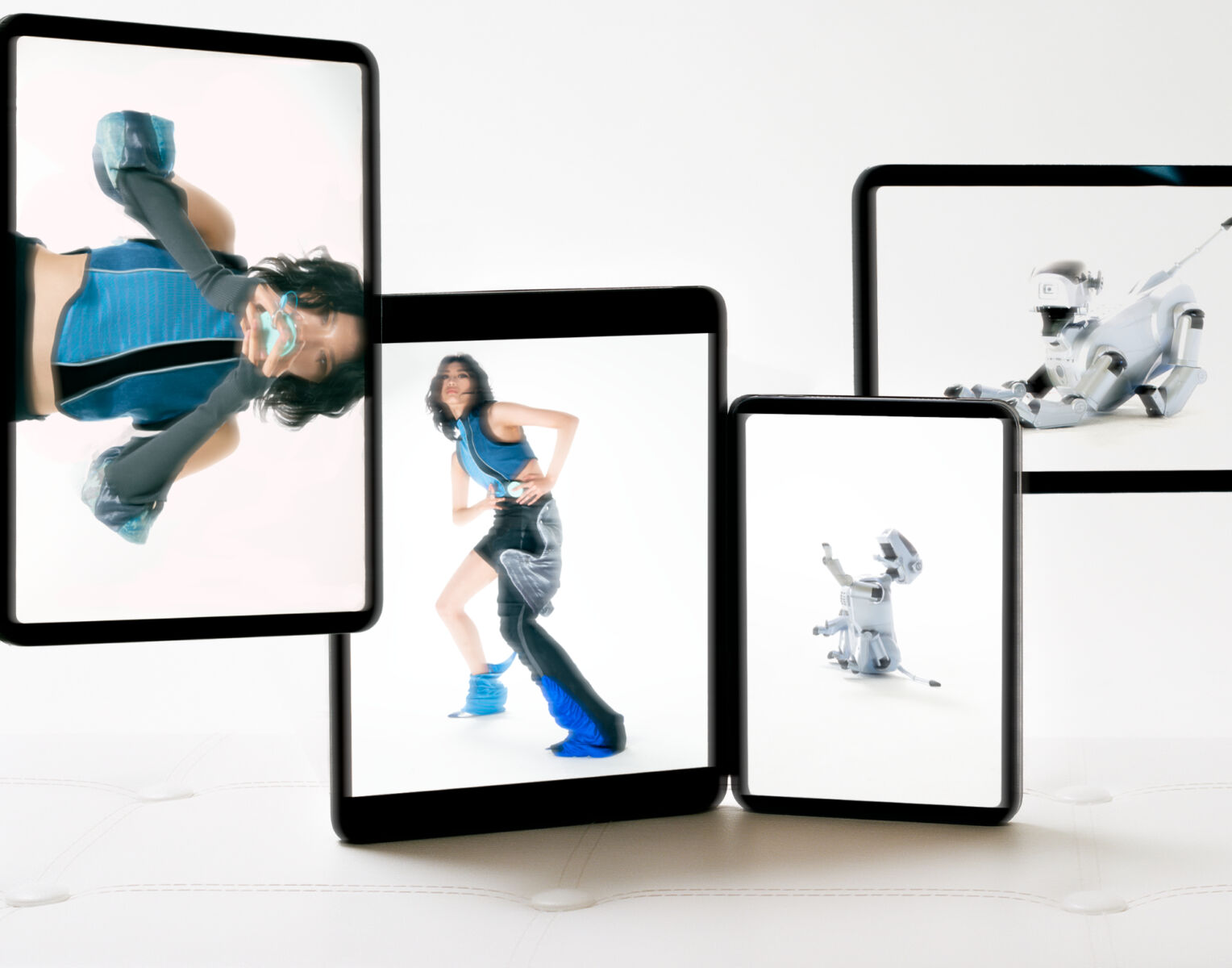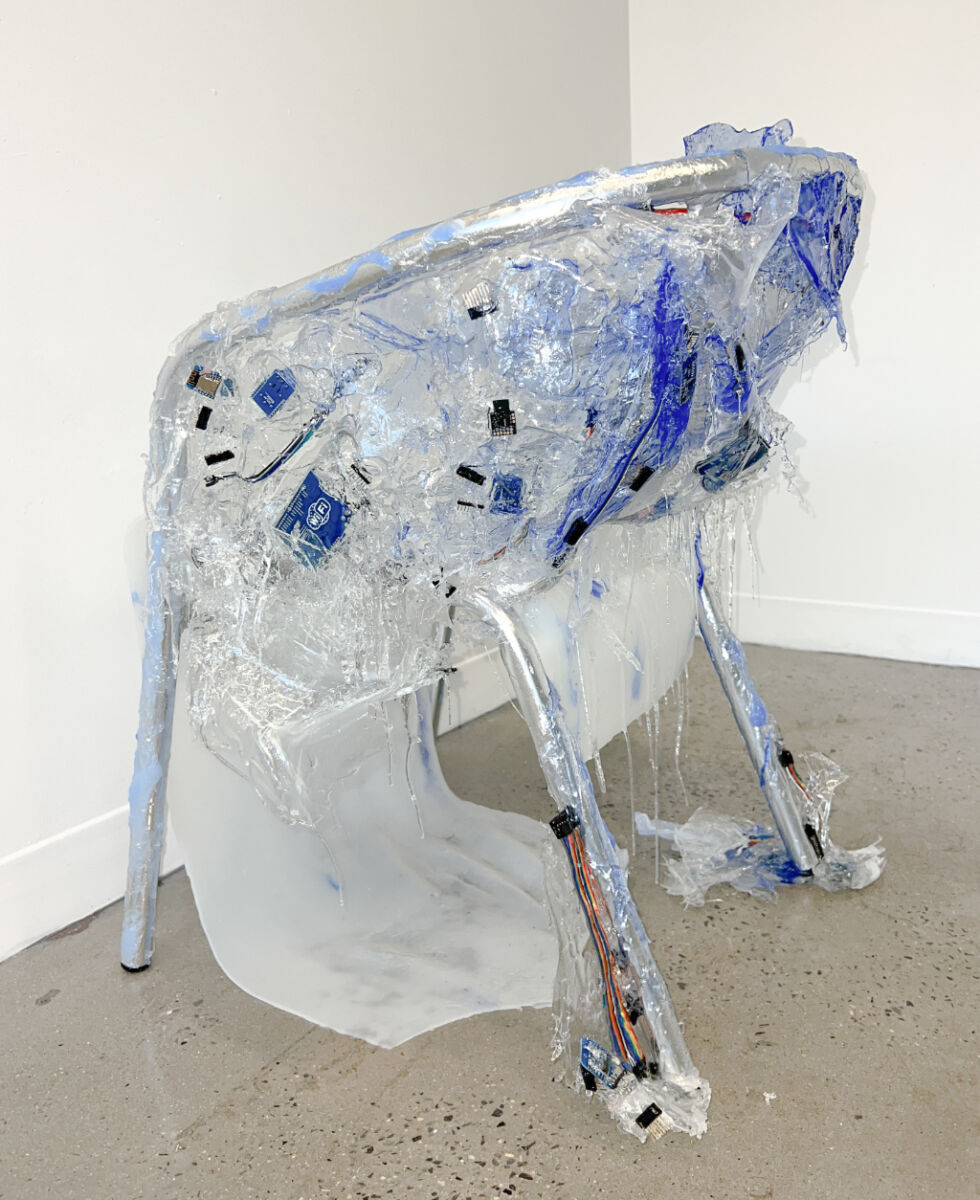Interview by Alessandra Coretti

Yuxuan Gong explores the intersections between the human and virtual dimensions with the attitude of an authentic polymath. Her portfolio—a bold visual manifestation of emotional landscapes—reflects on the interpersonal implications and social change in the era of digital progress. On the one hand, Gong confronts the dangers of alienation that the digital age exposes us to, for example, in Digital Nomadism. This project encodes digital nomadism as an escape from reality that can only find fulfilment in cyberspace. On the other hand, through a plot of emotional and intellectual frequencies, Gong creates a vortex of deep interconnections with her audience. She stirs thoughts, reactivates memories, and creates glitches.
In her works, narrative practices are intertwined with a critical stance, careful selection of colours and textiles, and an awareness of the dynamic quality of materials. One can glimpse the attitude of the great pioneers, those who recognise the power of relevant artistic experiences, and those who know that artistic encounters can affect the body and the neural level and reverberate in our consciousnesses to the point of triggering tangible transformations into the world [1].
It is not a coincidence that Gong conducted her studies at the Parsons School of Design in New York. Central to Gong’s compositional interests is an inextricable relationship between aesthetic research and social impact. In this context, Gong reinforces her tendency to transcend the boundaries of different disciplines, challenging herself with various tools and transforming her works into conceptual and textural art pieces.
For Disposable Love, Gong designs a virtual pet through algorithmic and immersive experimentation, highlighting how much it can satisfy the same emotional needs as a real dog. With this simple parallelism, the viewer gets lost in a perceptive game that shows a radical perspective shift between emotional responses and technological inputs – increasingly giving the impression of living in an unfreedom emotional dimension to get closer to a sphere of “programmed freedom.”
Yuxuan Gong’s work analyses interpersonal connections, portraying how they are deconstructed and restructured in a hyper-digitalised environment. But it also makes us ponder how design is evolving, transforming the problem of “shaping” today into a combination of political, scientific, artistic, social, identity, and economic instances [2]. Thus, it gives the discipline a hypertextual, open, and global application framework.



Your works, which range from fashion collections to art installations, are catalysts for contrasting emotions and contemporary tensions. Could you tell us more about how your projects’ creative and intellectual process unfolds? Which are the main pillars of your artistic vision?
Indeed, my creative process is deeply intertwined with my emotions and exploring conflicting feelings. I translate these emotions into evocative abstract drawings, employing gestural mark-making and experimental layering techniques. These drawings are the foundation for my fashion collections or art installations, guiding the thematic direction and visual aesthetic.
Central to my work is exploring tension and juxtaposition, reflecting the intricate nuances of the human experience. I delve into themes that resonate with contemporary society, often blurring the boundaries between reality and virtuality. Through my art, I explore how technology shapes human connections and emotions, probing the intersection of the digital and physical realms.
Ultimately, my artistic vision examines emotional complexities and explores societal shifts in the digital age. Each piece serves as a visual narrative, inviting viewers to contemplate the intricacies of human experience and the evolving landscape of modern life.
Given the variety of your expressive palette and the evocative/narrative power of your works, there is a perceived desire to transcend the boundaries of design (as a discipline that regulates form and function) in favour of a much more layered multi-disciplinary perspective. How have you developed this innovative approach to design? In pursuing your artistic identity, how important was your education at the prestigious Parsons School of Design in New York?
My multi-disciplinary approach to design is driven by a desire to transcend conventional boundaries and create immersive experiences that resonate emotionally and intellectually. Drawing inspiration from my emotional drawings, I infuse elements of storytelling and narrative into my creations. This approach allows me to convey more than just aesthetics; it enables me to communicate complex emotions and societal reflections through my work.
I honed my craft and refined my artistic vision at Parsons School of Design. The exposure to diverse perspectives, rigorous training, and creative environment provided me with the tools to push boundaries and explore unconventional ideas. Through hands-on projects and collaborative ventures, I developed a distinctive voice in design and art.
Today, my work is characterised by a holistic approach that engages viewers visually, emotionally, and intellectually. Each creation serves as a vessel for storytelling, inviting audiences to embark on a journey of exploration and discovery. This fusion of creativity, craftsmanship, and critical thinking continues to drive my passion for design and fuel my artistic endeavours.
Some of your works deal with the contradictions between digital and real-world experiences and the potential dangers of technology-induced alienation. This brings to mind other iconic designers such as Hussein Chalayan or Iris Van Herpen, who, through their clothes, have addressed significant themes such as identity, migration, ecology, etc. Do you believe in a possible transformative power of design? By spreading your work also through social media, what kind of impact would you like to generate on your community?
I firmly believe in the transformative power of design to provoke thought, challenge norms, and stimulate societal introspection. Through my work, I strive to spotlight the potential dangers of technology-induced alienation and ignite conversations about our evolving relationship with the digital world.
By sharing my creations on social media platforms, I endeavour to reach a broader audience and cultivate a community that reflects on the impact of technology on human connections. Through thought-provoking imagery and compelling narratives, I aim to spark dialogue, encourage critical thinking, and inspire individuals to question the evolving dynamics between digital and real-world experiences. Whether through interactive installations, provocative artworks, or engaging social media campaigns, I remain committed to using design as a catalyst for positive change and meaningful discourse in our increasingly digital age.
In Disposable Love: The Prosthetics of Presence, you created a virtual pet that generates real emotions. How did you carry this project out? Can technologies be a resource to push the boundaries of creativity already in the brainstorming process?
Disposable Love emerged from my fascination with the intersection of technology and emotional exploration. The project centered around creating a virtual pet that, despite being algorithm-based, had the remarkable ability to evoke genuine emotions and empathy from its users. Inspired by a dystopian vision of a future where technology dominates human interaction, I envisioned a world where virtual entities provide the primary source of emotional and physical companionship.
Technology played a pivotal role in the brainstorming process when conceptualising this project. Leveraging advanced algorithms and immersive virtual environments, I explored the possibility of creating a virtual entity that fosters authentic emotional connections with users. This innovative approach opened up new avenues for artistic expression and challenged traditional notions of creativity.
Through Disposable Love, I sought to provoke reflection on the evolving nature of human relationships in an increasingly digitised world. By blurring the lines between reality and virtuality, I aimed to prompt viewers to contemplate the implications of technology on our emotional experiences and interpersonal connections. Ultimately, the project served as a testament to the transformative power of technology in shaping our perceptions and interactions with the world around us.
In Digital Nomadism and Khoomei, the vibrational quality of your colours, fabrics, and materials is evident. How did you develop these projects and choose the mix of materials? How do they convey the project concept?
The vibrational quality in my projects “Digital Nomadism” and “Khoomei” results from a meticulous selection process for colours, fabrics, and materials. Inspired by the themes of each project, I conducted thorough research to ensure that the materials chosen conveyed a sense of connection to the digital/natural landscape and the emotional frequencies explored in each piece.
For example, in the Khoomei project, I drew inspiration from traditional Mongolian culture and developed an accessory using the reins Mongolians used to tame their horses. This choice pays homage to Mongolian heritage and adds a tactile element that enhances the sensory experience of the project. Additionally, the use of vibrant colours and innovative materials embodies the concepts of digital nomadism and the traditional Mongolian singing method of Khoomei.
Each element in both projects is carefully curated to encapsulate the essence of the themes and evoke a visceral response from the audience. Through meticulous research and thoughtful design choices, I aimed to create immersive experiences that resonate with viewers on both an emotional and aesthetic level.
In the context of creativity, what is more important, in your opinion: to take or not to take yourself too seriously?
I’ve learned not to take myself too seriously in my design process. It’s common to find that someone has already explored the ideas I want to pursue, and often, they’ve executed them far better than I could ever imagine. Instead of getting discouraged, I see it as an opportunity to experiment and twist things.
There’s nothing new under the sun, but there’s still room for innovation. Even if it’s just a tiny twist, I enjoy exploring how to bring my perspective to existing concepts. It’s not about reinventing the wheel but adding my flavour.
By embracing this mindset, I create a space to take risks and push boundaries without the fear of failure holding me back. I’ve found that some of my most creative breakthroughs have come from playful experimentation, allowing me to let go of perfectionism and see where my imagination takes me.
Ultimately, the ability to not take myself too seriously fosters a creative environment where innovation thrives and new ideas can flourish. It’s about embracing the journey of discovery and finding joy in the creation process, no matter how slight the twist may be.
Solitude or loneliness: how do you spend your time alone?
Solitude is not just a preference but an essential component of my creative process. In the quiet confines of my tiny apartment, I find the space and tranquillity needed to connect with my emotions and thoughts. Alone with my thoughts, I engage in activities that fuel my creativity, such as sketching, reflecting on inspirations, and meditating. These moments of solitude are a time for creative exploration, self-discovery, and contemplation.
Through solitude, I recharge and bring a renewed perspective to my work. It’s a time to disconnect from the world’s noise and reconnect with my innermost thoughts and feelings. In this state of introspection, I find clarity and inspiration that often elude me in more bustling environments.
While solitude is a conscious choice for creative exploration, I aim to address loneliness through art. My work delves into the societal implications of technology on human connection, sparking conversations about the impact of digital communication on our sense of belonging and community. By exploring themes of isolation and disconnection, I hope to shed light on the complexities of modern life and provoke thought and reflection in my audience.
Ultimately, solitude serves as a sanctuary and a source of inspiration in my creative journey. It’s where I find the space to explore my ideas and emotions freely and draw the strength to confront the challenges of loneliness through my art.





